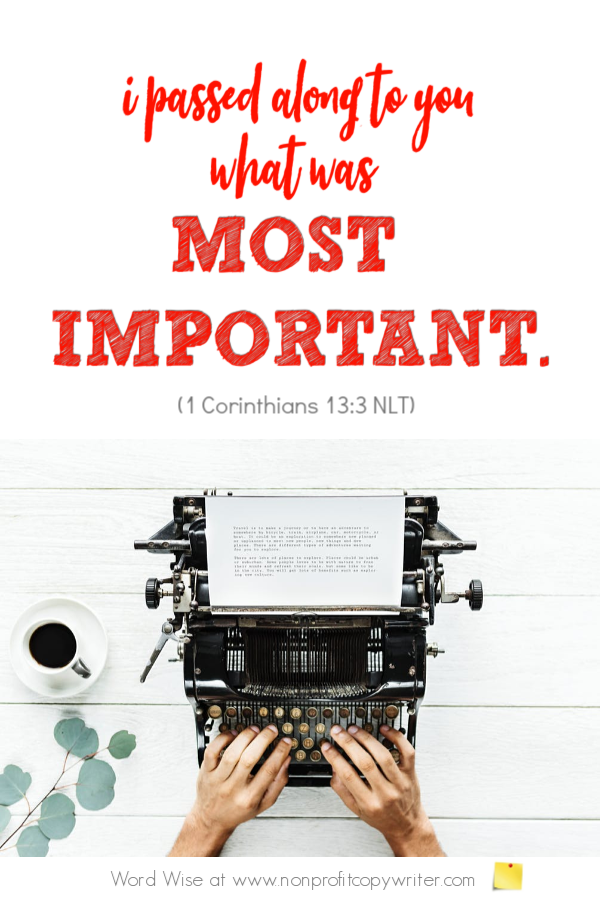Save Time: Get 5 Simple Writing Tips
you can put to use in 10 minutes
The First 100 Words:
Write a Summary. Place It at the Top
Award-winning writer Kathy Widenhouse has helped hundreds of nonprofits and writers produce successful content , with 750K+ views for her writing tutorials. She is the author of 9 books. See more of Kathy’s content here.
An online devotional for writers
A Word From The Word
I passed on to you what was most important. (1 Corinthians 15:3, NLT)
A Word For Writers
Write a summary first.
This structure is called an “inverted pyramid.” Journalists write a summary and place it at the top of an article, allowing readers to get the gist of the story from the opening few paragraphs.
This “first news first” approach has been a journalist’s go-to format since the rise of the telegraph and expansion of newspapers in the 1800s.
Reading the first 100 words of an article makes sense when you face wading through a thick, daily newspaper. You get a grasp of lots of different pieces of news in a shorter time.
Now, decades later, it’s the preferred structure for web users too.
Bloggers have discovered that just half their readers actually read past the first 100 words of a post. Web usability stats tell us the same thing: eye tracking studies report that web users read an average of just 20% words on a web page.
Your readers can dip below the first 100 words if they choose to dig deeper. The content explosion has limited their reading time. The “first news first” rule of thumb puts your reader’s needs before your own.
Paul shared the importance of prioritizing your content for your readers: “I passed on to you what was most important” (1 Corinthians 15:3, NLT). He wanted to make sure his readers got the message that Jesus died for them.
Shouldn’t we put our readers’ needs first, too?
A Wise Word
Let your first 100 words put your reader first.
A Word To Pray
Gracious Father,
I confess that at times, I become attached to my words. Let me put my reader’s needs first. Show me how to write a summary and place it near the top of content so my reader can gain a quick understanding of my point.
In Jesus’s name I pray. Amen.
More Devotionals for Writers
The Section Break: Give Readers A Chance to Think ...
The Revision: It’s Where the Real Writing Happens ...
The Bullet List: Are Yours Random?
The Short Sentence: Throw in Few to Improve Readability ...
The Signal Word: Write a Conclusion Using Paul’s Technique ...
The Short Form Content: Digest a Point In 2 Minutes or Less ...
The Edit: Know When It’s Time to Fix, Throw Away, and Keep ...
The Power Word: This One Is Simple, But It Moves Readers to Act ...
The Readability Tool: Why You Should Write Like an 8th Grader ...
The Overworked Words: They're a Signal to Be Bold in Your Writing ...
The Synonym: A Clever Way to Repeat Yourself and Write Persuasively ...
The LOI: The First Step in Writing Grant Proposals That Succeed ...
The Trigger Word: Special Content Writing Keywords Move Us to Act...
The List: A Surprising Reason it’s a Good Content Writing Tool ...
Extra Words: How to Cut Them Out (and Why You Should) ...
Six Words: The Case for Clear Headlines and Ad Copy ...
One Word: Does Word Choice Make a Difference?
Two Words: Which Should I Choose?
Wise Words: more devotionals for writers ...
More devotionals for writers on our Pinterest board ...
Get more devotionals for writers delivered to your inbox each week:
Return from Write a Summary to Word Wise at Nonprofit Copywriter
As an Amazon Associate I earn from qualifying purchases.
Share This Page

Named to 2022 Writer's Digest list
BEST GENRE/NICHE WRITING WEBSITE


Stop Wasting Time!
Grab your exclusive FREE guide, "5 Simple Writing Tips You Can Put to Use in 10 Minutes or Less"












